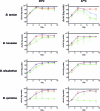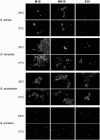Combining culture techniques for Bartonella: the best of both worlds
- PMID: 21289156
- PMCID: PMC3122786
- DOI: 10.1128/JCM.02403-10
Combining culture techniques for Bartonella: the best of both worlds
Abstract
In this study we compared some common Bartonella culturing methodologies using four diverse species causing human illnesses. Based on a review of the literature, we focused on three major inconsistencies between protocols: base medium, cell coculture, and temperature. Our data showed that Bartonella tamiae demonstrated temperature-dependent growth limitations between common culturing conditions only 2°C apart. Additionally, growth of B. quintana was significantly enhanced by the presence of mammalian cell coculture under mammalian cell culture conditions; however, when the medium was modified to incorporate insect cell culture-based medium, coculturing with mammalian cells was no longer needed. In this study, we were able to overcome these temperature- and cell-dependent limitations and accommodate all of the strains tested by combining mammalian cell culture-based medium with insect cell culture-based medium.
Figures


References
-
- Bai Y., et al. 2010. Enrichment culture and molecular identification of diverse Bartonella species in stray dogs. Vet. Microbiol. 146:314–319 - PubMed
-
- Battisti J. M., Minnick M. F. 2008. Laboratory maintenance of Bartonella quintana, p. 1-1–1-13 In Current protocols in microbiology, unit 3C. John Wiley & Sons, Inc., New York, NY - PubMed
Publication types
MeSH terms
Substances
LinkOut - more resources
Full Text Sources
Molecular Biology Databases

